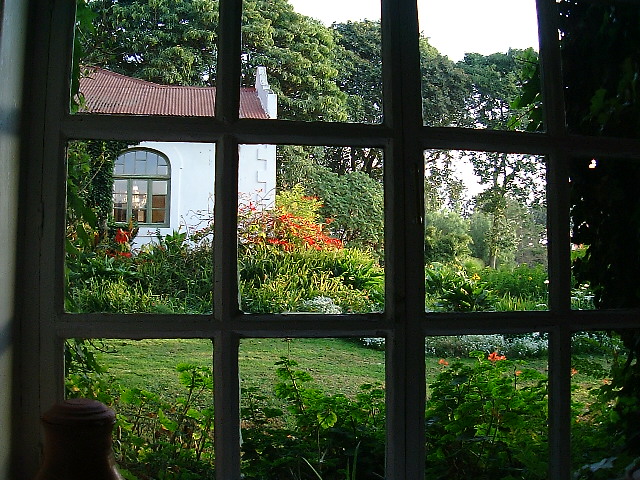|
by John Fuhring The Uto Farm The Uto Farm was developed by a German fellow in the 1930's (after the British "graciously" allowed Germans back in). The Farm was originally a coffee plantation, but coffee hasn't been grown commercially there for decades.  Geographically, the Uto Farm is at 3.185 degrees south of the equator and 36.685 degrees east of the Prime Meridian (Greenwich Meridian). The time there is three hours ahead of UTC (Greenwich Mean Time in the old reckoning) and conforms to East African Standard Time. Summer and winter, spring and fall are only meaningful in terms of the season of the long rains and the short rains. The days (no matter what the season) are almost exactly 12 hours long as are the nights. Sunrise is always at or around 6:30 AM and sunset is always at or around 6:30 PM with very short periods of twilight. For some reason, twilight at dawn seems to be longer, but I never measured it accurately so that may only be a subjective impression. The Farm is located on the western slope of a beautiful composite stratovolcano, 14,000 foot high Mt. Maru, at about 6,400 feet above sea level. At that altitude, the mornings and evenings are quite cool and you need a light jacket for comfort out of doors. During the day the temperatures are very comfortable. The Farm is located at a zone of elevation that mimics a perpetual spring time. It is as nice a climate as any place on earth as far as I'm concerned. The perpetual spring climate of this high altitude place is the reason the farm was originally planned as a coffee plantation. I have no doubt it produced some wonderful high altitude Arabic coffee, but the market has always been such that most plantations in East Africa failed a long, long time ago (read The Flame Trees of Thika and Out of Africa). Lately, from everything I heard, the few coffee plantations remaining are really having a hard time even though (in my opinion) their coffee is the best in the world. How ironic that "Threebucks Coffee (AKA Starbucks)" costs so much for the spoonfull of processed coffee they use in a cup, yet the native growers only get that kind of money per ten kilograms - something's wrong here.
Not only do coffee trees
grow well, it seems that everything up here grows well too.
From
the pictures, you can see many species of beautiful flowers growing in
the gardens together with huge Australian Gum (eucalyptus) trees,
avocado
trees and lots and lots of plants I don't know the names of.
Speaking
of avocados, they do especially well up there and when you consider the
price fresh avocado and avocado oil fetches in the U.S. (and especially
Japan), there might be a potential to develop this as a cash crop if
you
could get the avocados and/or the oil to a world market.
Unfortunately,
the transportation infrastructure in this country is so poor that
development
of this nature would be decades away if ever. Scenes from around the dairy pastures. 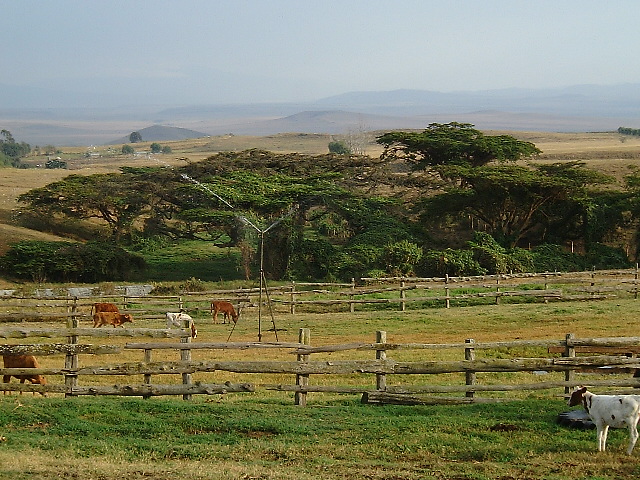 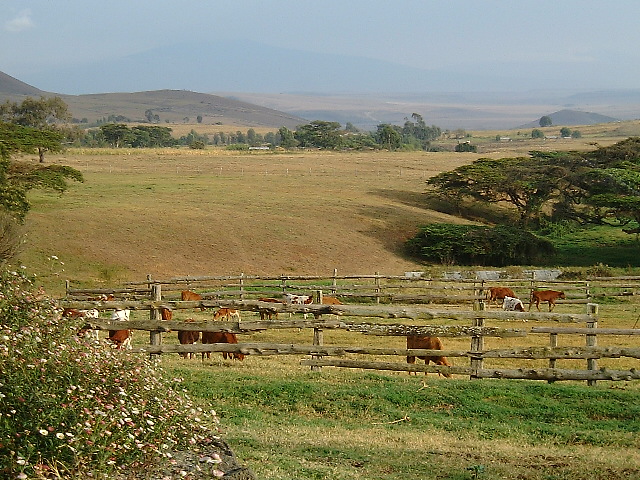 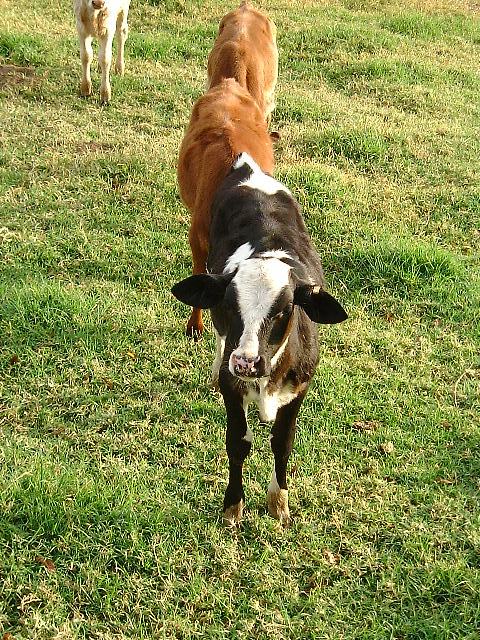  In addition to the dairy operations, the farm is the headquarters of horseback safaris and a stable full of horses are kept in the rear along with their tack.
There are several guest rooms on the property. The guest cottages are set within the beautiful gardens with scenes like the following: 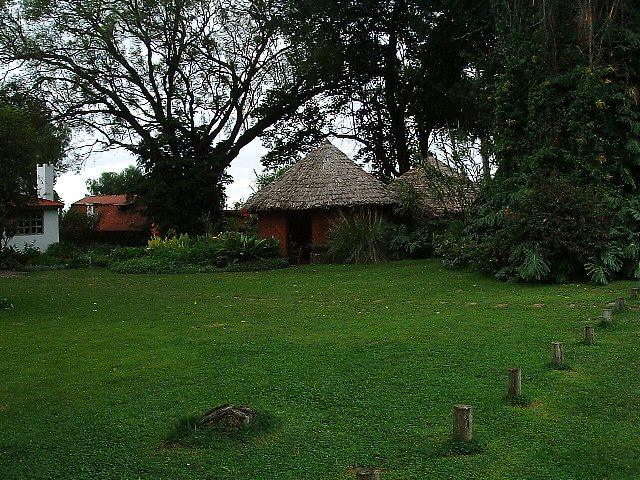 Native style guest
houses.
Scene looking
through my guest
cottage window
towards the main house.
As I have stated in other places, the Uto Farm is one of the prettiest places you will ever visit and is certainly the prettiest place I have seen in my limited travels in Africa. As a matter of fact, I can't think of anywhere I've ever been that has such beautiful gardens - the layout is brilliant and they must have a small army of natives to keep the place looking so great. 
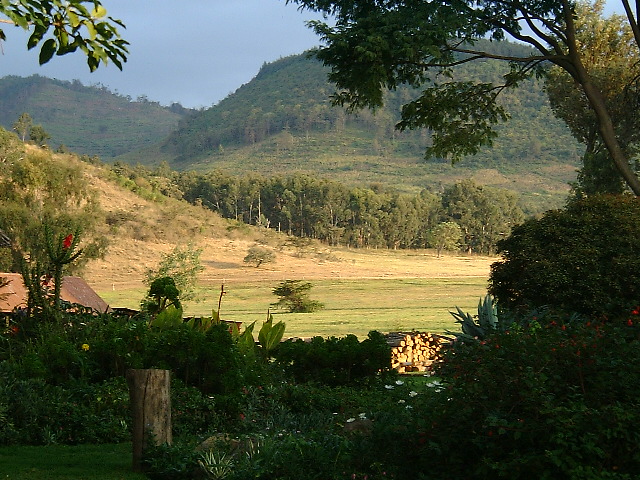 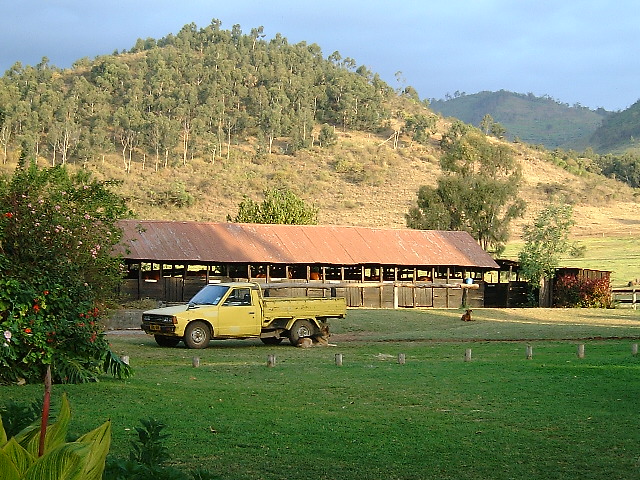 As mentioned, there is electricity from the generator in the evenings or when they want to watch the new satellite TV, but as in all of this part of Africa, hot water is only available when somebody makes a fire. Here's how it works: Cold water from a high spring enters a pipe where it is conducted down to the farm. At the farm the water is under considerable pressure (called head pressure). The cold water from the spring is piped to the top drum (see picture below) and fills the drum through a float valve. The water is then fed by gravity to the bottom of the red drum. A fire heats the water in the red drum and hot water then can exit the drum at the top. There is a long tube from the top of the red drum extending to above the top drum to vent off any trapped gas or steam in case the water starts to boil. This is a safety feature to prevent dangerous pressures building up which might explode the red drum. This little boiler is so simple, it's made with readily avail scrap and natural materials, very reliable and it works absolutely great. Only drawbacks are that somebody has to make a fire and keep it going and it's impossible to regulate the exact temperature of the hot water.
|

